Rajasthan Board RBSE Class 11 Economics Chapter 8 Arithmetic Mean
RBSE Class 11 Economics Chapter 8 Text book Questions
RBSE Class 11 Economics Chapter 8 Multiple Choice Questions
Question 1.
In order to present the properties of data-items in a concise form, calculation is done by
(a) Statistical method
(b) Statistical mean
(c) Statistical Formulae
(d) Tabulation
Answer:
(b) Statistical mean
Question 2.
The objective of arithmetic mean is to find-
(a) Average value of items
(b) Arithmetic value of items
(c) Mid-value of items
(d) All of these
Answer:
(d) All of these
![]()
Question 3.
In which mean is algebraic investigation possible-
(a) Arithmetic mean
(b) Median
(c) Mode
(d) All of these
Answer:
(a) Arithmetic mean
Question 4.
If X1 = 4, X2 = 5, N1 = 10, N2 = 15, then collective mean would be
(a) 4.5
(b) 4.6
(c) 5
(d) 4.8
Answer:
(b) 4.6
Question 5.
The sum of deviations taken from arithmetic mean for any series is
(a) Maximum Sum
(b) Minimum Sum
(c) Zero
(d) Infinity
Answer:
(c) Zero
RBSE Class 11 Economics Chapter 8 Very Short Answer Type Questions
Question 1.
Which are the place-related means?
Answer:
Median(M) and Mode (Z)
Question 2.
Mention the main difference between simple and weighted arithmetic means.
Answer:
Equal value is given to all values in simple average mean, whereas in each weighted average mean, importance is given to each value according to its weight.
Question 3.
When is step-deviation method used to determine arithmetic mean?
Answer:
If the class magnitude is the same in the continuous category, and if the number of class-intervals is large, then the step-deviation method is used to further simplify the shortcut method.
Question 4.
Which are means of first order?
Answer:
Arithmetic mean
![]()
Question 5.
Write the formula to determine collective arithmetic mean.
Answer:
\(\overline { X } ={ \overline { X } }_{ 1,2 }=\frac { { N }_{ 1 }{ \overline { X } }_{ 1 }+{ N }_{ 2 }{ \overline { X } }_{ 2 } }{ { N }_{ 1 }+{ N }_{ 2 } } \)
RBSE Class 11 Economics Chapter 8 Short Answer Type Questions
Question 1.
Prove, using an example, that the sum of deviations of various values from arithmetic mean is always zero.
Answer:
Example X : 4 6 8 10 12
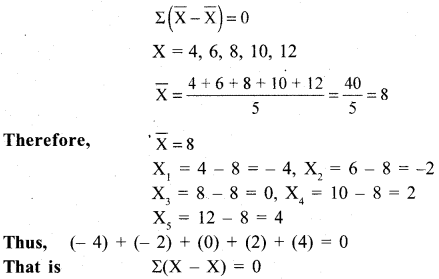
Question 2.
What would be the effect on the arithmetic mean of a series if a constant (definite) quantity is added to, subtracted from, multiplied into or divides each value of the distribution.
Answer:
If one constant quantity (k) is added to or subtracted from all the item-values of any series, then the arithmetic mean will become \(\overline { X } \) + k or \(\overline { X } \) – k respectively. If the constant (k) is multiplied by all the item-values of a series or if item values are divided by constant quantity (k), then the changed arithmetic mean will become respectively : k\(\overline { x } \) or \(\overline { x } \)/k accordingly.
Question 3.
Write any four characteristics of an ideal mean.
Answer:
Following are the four characteristics of an ideal mean:
- It should be defined clearly :
The mean should be defined very clearly so that it has only one implication. - It should be simple to understand and simple to compute:
The mean should be such that it is simple to understand and simple to compute. - It should be based on all the values :
An ideal mean should be based on all the values of the series. Without this, this mean will not represent the data-item series correctly. - It should be the least affected by extreme values (maximum/ minimum) :
The extremely small and extremely large values of a data-items series should have the least effect on the mean.
Question 4.
Explain statistical mean.
Answer:
Statistical mean is such a representative value of the data series that highlights the key feature of the data series, and around which tendency of other data in the data range to concentrate is found. This is the most popular measure of central tendency. The reason for this is its simple calculation method.
![]()
Question 5.
What is the objective behind study of means?
Answer:
Statistical means have a considerable use in practical life. With their help, systematic and complex data is presented in simple form. It represents the entirety. Two or more groups can be compared. It presents a basis in the process of other statistical analysis, and in determining future policies, these serve as a guide.
RBSE Class 11 Economics Chapter 8 Long Answer Type Questions
Question 1.
What is meant by measures of central tendency? Explain the characteristics of an ideal mean.
Answer:
Meaning of Measures of Central Tendency :
There is a point in every data series around which all other data values tend to centre or concentrate. This value is located approximately at the centre of the series, and represents its important characteristics. This value itself is called the measure of central tendency or mean.
According to Simpson and Kafka :
“The measure of central tendency is such a representative value, towards which other values tend to concentrate.”
Following are the four characteristics of an ideal mean :
- It should be defined clearly :
The mean should be defined very clearly so that it has only one implication. - It should be simple to understand and simple to compute :
The mean should be such that it is simple to understand and simple to compute. - It should be based on all the values :
An ideal mean should be based on all the values of the series. Without this, this mean will not represent the data-item series correctly. - It should be least affected by extreme values (maximum/ minimum) :
The extremely small and extremely large values of a data-items series should have the least effect on the mean. - It should be helpful in other algebraic investigations :
An ideal statistical mean should have such mathematical qualities that it may help in further algebraic investigation. For example, if we know the mean values and frequencies of some groups of data, then the collective mean value of these groups could be known.
Question 2.
Find the number of children (x) if the arithmetic mean of age in the following series is 11.9 years.
Answer:
| Age (in years) | Number of Children |
| 0.5 – 5.5 | 3 |
| 5.5- 10.5 | 17 |
| 10.5- 15.5 | X |
| 15.5- 20.5 | 8 |
| 20.5- 25.5 | 2 |
Answer:
| Age (in years) | Mid-point X | No. of Children (f) | fx |
| 0.5-5.5 | 3 | 3 | 9 |
| 5.5-10.5 | 8 | 17 | 136 |
| 10.5-15.5 | 13 | X | 13X |
| 15.5-20.5 | 18 | 8 | 144 |
| 20.5-25.5 | 23 | 2 | 46 |
| N = 30 + X | Σfx = 335 + 13X |
\(\overline { X } =\frac { \Sigma fx }{ N } \)
Or
\(11.9=\frac { 335+13X }{ 30+X } \)
Or
357 + 11.9X = 335 + 13X
13X – 11.9 X = 357 – 335
1.1X = 22
X =22/1.1= 20
So, the missing term X = 20
![]()
Question 3.
Find the arithmetic mean, median and mode in the following frequency distribution.
| Class | Frequency |
| 0-5 | 3 |
| 5-10 | 4 |
| 10-15 | 6 |
| 15-20 | 12 |
| 20-25 | 0 |
| 25-30 | 14 |
| 30-35 | 6 |
| 3540 | 5 |
Answer:
Computation of Mean, Median & Mode
| Class | Mid-value X | Frequency f | Fx | c.f. |
| 0-5 | 2.5 | 3 | 7.5 | 3 |
| 5-10 | 7.5 | 4 | 30 | 7 |
| 10-15 | 12.5 | 6 | 75 | 13 cf |
| 15-20 | 17.5 | 12 | 210 | 25 |
| 20-25 | 22.5 | 0 (f0) | 0 | 25 |
| 25-30 | 27.5 | 14 (f1) | 385 | 39 |
| 30-35 | 32.5 | 6 (f2) | 195 | 45 |
| 35-40 | 37.5 | 5 | 187.5 | 50 |
| N = 50 | Σfx = 1090 |
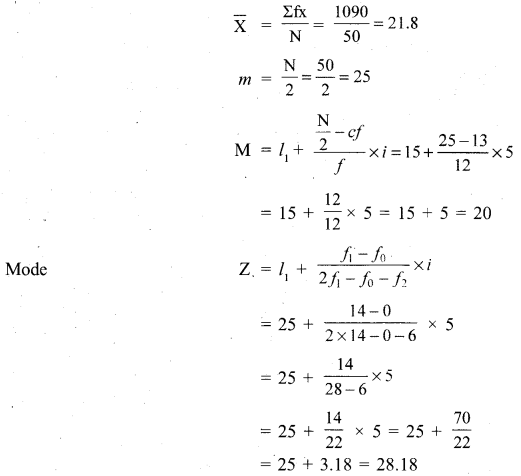
Question 4.
Find the weighted mean from the data given below:
| Head | Expenditure (₹) | Weight |
| Food | 940 | 7.5 |
| Rent | 200 | 2.5 |
| Clothes | 500 | 1.5 |
| Fuel | 250 | 1.0 |
| Other Heads | 240 | 0.5 |
Answer:
Calculation of Weighted Mean
| Head | Expenditure (₹) | Weight | WX |
| Food | 940 | 7.5 | 7050 |
| Rent | 200 | 2.5 | 500 |
| Clothes | 500 | 1.5 | 750 |
| Fuel | 250 | 1.0 | 250 |
| Other Heads | 240 | 0.5 | 120 |
| Σw = 13 | ΣXw = 8670 |
\(\overline { X } =\frac { \Sigma Xw }{ \Sigma w } \) = \(\frac {8670}{13} = 666.92 \)
![]()
RBSE Class 11 Economics Chapter 8 Other Important Questions
RBSE Class 11 Economics Chapter 8 Objective Type Questions
Question 1.
Which average is most affected in the presence of extreme positions?
(a) Median
(b) Mode
(c) Arithmetic Mean
(d) None of these
Answer:
(c) Arithmetic Mean
Question 2.
The algebraic sum of the deviation of a set of values from the arithmetic mean is
(a) -1
(b) 0
(c) 1
(d) None of these
Answer:
(b) 0
Question 3.
The value obtained by dividing the sum of all the values in a data series, by the number of values is
(a) Median
(b) Mode
(c) Arithmetic Mean
(d) None of these
Answer:
(c) Arithmetic Mean
Question 4.
Which one of the following is not a mathematical mean?
(a) Arithmetic mean
(b) Geometric mean
(c) Mode
(d) Harmonic mean
Answer:
(c) Mode
![]()
Question 5.
Which one of the following mean is related to place?
(a) Median
(b) Arithmetic mean
(c) Geometric mean
(d) Harmonic mean
Answer:
(a) Median
Question 6.
Which mean is the most affected by marginal values?
(a) Mode
(b) Arithmetic mean
(c) Median
(d) Geometric mean
Answer:
(b) Arithmetic mean
Question 7.
Each item of the series is included in the calculation
(a) In mode
(b) In median
(c) In arithmetic mean
(d) In all of these
Answer:
(c) In arithmetic mean
Question 8.
Mid-value of 10-15 is
(a) 10
(b) 12.5
(c) 15
(d) None of these
Answer:
(b) 12.5
Question 9.
Measure of central tendency is
(a) Arithmetic mean
(b) Mean deviation
(c) Standard deviation
(d) Correlation
Answer:
(a) Arithmetic mean
![]()
Question 10.
The mean of the given series- 2, 5, 3, 6, 4 is
(a) 4
(b) 3
(c) 7
(d) None of these
Answer:
(a) 4
RBSE Class 11 Economics Chapter 8 Very Short Answer Type Questions
Question 1.
How many types of means are related to place?
Answer:
Two
Question 2.
How many types of mathematical means are there?
Answer:
Four Types
Question 3.
Write the names of any two types of mathematical means.
Answer:
- Arithmetic Mean
- Geometric Mean
Question 4.
Generally, the mean used by the common man in daily life is?
Answer:
Arithmetic Mean
Question 5.
By which symbol is the arithmetic mean expressed?
Answer:
By \(\overline { X } \)
Question 6.
Of how many types is the arithmetic mean?
Answer:
Two Types
![]()
Question 7.
Write the names of the types of arithmetic mean.
Answer:
- Simple/unweighted Arithmetic Mean
- Weighted Arithmetic Mean
Question 8.
Write the formula of arithmetic mean by the direct method in the individual series.
Answer:
\(\overline { X } \) = ΣX/ N
Question 9.
What is the use of shortcut method in the individual series?
Answer:
When the number of values in a series is high, the numbers are large, in decimal, then the shortcut method is used.
Question 10.
Write the formula for the arithmetic mean in shortcut method.
Answer:
\(\overline { X } \) = A + Σd/N
Question 11.
What is the sum of deviation of different item values taken from the arithmetic mean?
Answer:
Always Zero
Question 12.
What is that arithmetic mean called which is calculated on the basis of weight?
Answer:
Weighted arithmetic mean
![]()
Question 13.
Write the formula of arithmetic mean, which is calculated by the step deviation method.
Answer:
\(\overline { X } \) = A + Σfd’/N × i
Question 14.
Define arithmetic mean.
Answer:
The arithmetic mean of a series is the value which is obtained by dividing the sum of all the values of the series by the number of items present in it.
Question 15.
Which mean is mostly used?
Answer:
Arithmetic mean is mostly used.
Question 16.
Differentiate between simple arithmetic mean and weighted arithmetic mean.
Answer:
In the calculation of simple arithmetic mean, all the item values are given equal importance, whereas in weighted arithmetic mean each item is given weight on the basis of its significance.
Question 17.
Write two characteristics of ideal mean.
Answer:
- It should be defined clearly.
- It should be simple to understand and simple to compute.
Question 18.
Write the name of commercial means.
Answer:
- Variable mean
- Progressive mean
- Documented mean
Question 19.
Write the formula of arithmetic mean in discrete series.
Answer:
\(\overline { X } \) = ΣfX/N or Σf
![]()
Question 20.
Write two flaws of arithmetic mean.
Answer:
- It is effected by the extreme values.
- It cannot be estimated from the mere observation of the series.
Question 21.
Write the two purposes of statistical means.
Answer:
- With the help of means, we can present complex data in a simple and concise form.
- Measures of central value , by reducing the volume of data to single figure, enable comparison to be made.
Question 22.
Write the formula of computing weighted arithmetic mean.
Answer:
Xw = \( \frac{\Sigma Xw}{\Sigma W}\)
Question 23.
What kind of series is 2, 5, 7, 10, 13, 15?
Answer:
Individual series
Question 24.
What kind of series is 0-10, 10-20, 20-30?
Answer:
Continuous series
RBSE Class 11 Economics Chapter 8 Short Answer Type Questions
Question 1.
Explain the characteristics of an ideal mean.
Answer:
Following are the characteristics of an ideal mean-
- Representation :
The mean should be that which correctly represents the whole, it means that the maximum attributes of the whole should be found in it. - Simple :
Mean should be simple to understand and calculate. - On the basis of all the items :
Mean should be based on all the items. - Arithmetic description should be possible :
It should be possible to obtain the algebraic interpretation of mean. - The lowest impact of change :
There should not be any impact on the mean, due to change of some units of the whole. - Less affected by marginal prices :
The marginal values should not have much effect on the mean, otherwise the mean can be delusional. - Definite number :
There must be a certain number of mean.
![]()
Question 2.
Explain four characteristics of arithmetic mean.
Answer:
Following are the four characteristics of arithmetic mean-
- Its algebraic use is possible.
- Its calculation is simple.
- It keeps all the items in mind.
- It is the most popular medium for comparative study.
Question 3.
Explain four flaws of arithmetic mean.
Answer:
Following are the four flaws of arithmetic mean-
- In its calculation, the marginal values have a great effect.
- It is not possible to calculate it by the graphical method.
- It is not suitable to study the ratio and rate, etc.
- It can not be used for qualitative data.
Question 4.
What is the difference between simple and weighted arithmetic mean?
Answer:
Following are the differences between simple and weighted arithmetic mean:
- Equal importance is given to all values in simple arithmetic mean, while in weighted arithmetic mean, weight is given to each value according to its importance.
- The simple arithmetic mean does not represent a series, as well as the weighted arithmetic mean does.
- Conclusions drawn on the basis of simple arithmetic mean sometimes are quite misleading, whereas in weighted arithmetic mean this does not happen.
Question 5.
Explain weighted arithmetic mean. Write its formula.
Answer:
In practice, the various values of many data-item series have varying relative importance. Thus, while calculating the arithmetic mean in such series, the relative importance of values has to be taken into consideration. The relative importance of units is expressed in definite number. These numbers are called weights. The arithmetic mean, calculated on basis of weight, is called weighted arithmetic mean.
\(\overline { X } \)w = ΣXW/ΣW
![]()
Question 6.
Explain the characteristics of arithmetic mean.
Answer:
Following are the characteristics of arithmetic mean:
- The sum of deviations of item-values from arithmetic mean is always equal to zero – i.e. Σ(x – \(\overline { x } \)) = 0
- The sum of squares of deviations of various item-values taken from arithmetic mean is minimum- i.e., Σ(x – x)² is minimum.
- Determination of unknown value. if any two measures out of \(\overline { X } \), N and ΣX are known, then the third measure can be determined:
\(\overline { X } = \frac{\Sigma x}{N}, \Sigma x = N\overline { X }, N = \frac{\Sigma x}{\overline { X }}\) - Determination of collective arithmetic mean: If the arithmetic means of two or more parts of a group, and the number of items is known, then, on this basis, collective arithmetic mean can be determined.
\({ \overline { x } }_{ 1,2 }=\frac { { N }_{ 1 }{ \overline { X } }_{ 1 }+{ N }_{ 2 }{ \overline { X } }_{ 2 } }{ { N }_{ 1 }+{ N }_{ 2 } } \)
Question 7.
Explain the uses of arithmetic mean.
Answer:
Since among all statistical means, arithmetic mean is more simple and simple to calculate, it is more useful for study of economic and social problems. It is of extensive use in determining average production, average investment (cost), average income, average import-export, average bonus, etc. Despite effect of extreme values, unrepresentative nature, misleading results being its disadvantages, arithmetic mean can be considered to be the ideal mean.
RBSE Class 11 Economics Chapter 8 Long Answer Type Questions
Question 1.
What do you mean by arithmetic mean? Explain the merits and demerits of arithmetic mean.
Answer:
Meaning of arithmetic mean :
Arithmetic mean is the most popular and important means among mathematical means, which is generally used by the common man in routine life. The arithmetic mean of a series is the value which is obtained by dividing the sum of all the values of the series by the number of items present in it.
According to H.Secrist :
“ Arithmetic mean is the amount secured by dividing the sum of values of the items in a series by their number.”
Thus, it is clear that the arithmetic mean is found in the sum of all the values of a general category, divided by the number of values.
For example, if the monthly income of 5 families is ? 2000, 3000, 4000, 5000 and ? 6000, then for finding out the arithmetic mean or average income of the families, the incomes of all these households is added together, which is Rs. 20000 and then total income will be divided by the total number of items which is 5, The average monthly income will be Rs. 4000, that is the arithmetic mean. Arithmetic mean is of two types
- Simple Arithmetic Mean
- Weighted Arithmetic Mean
Merits of Arithmetic Mean :
Following are the merits of arithmetic mean
- Easy to compute and understand :
It is the simplest average to understand and easiest to compute. A layman can also understand it easily. - Based on all items of the series :
It takes into consideration every item in the series in computation. Thus, it is a good representative value. - Definitiveness :
It is defined by a rigid mathematical formula with the result that everyone who computes the average gets the same answer. - Stability :
In comparison to other averages, mean is quite stable. It does not vary too much when repeated samples are taken from one and the same population, at least not as much as some other kind of statistical descriptions do. - Suitable for algebraic treatment :
Being determined by a rigid formula, it lends itself to subsequent algebraic treatment better than the median or mode. - No need for arranging data :
It is not necessary to arrange the values in an array form. - Comparative Study :
With its help, two series can be easily compared. - Calculation of Unknown Values :
If among the arithmetic mean, number of items and sum of items, any one is unknown, then it can be calculated using the two known values.
![]()
Following are the demerits of arithmetic mean:
- Effect of extreme value :
The value of arithmetic mean depends upon each and every item of the series. Therefore, extreme items, i.e. very small and very large items affect the average figure disproportionately. - Unrealistic :
Sometimes it may represent such figure which seems to be unrealistic. - Graphical representation is not possible :
It cannot be located by graphic method. - Calculation difficulties :
In comparison to positional averages, calculation of arithmetic mean is more difficult because- It cannot be located by mere inspection, while some other averages can be located by mere inspection.
- It cannot be determined even if one of the values is not known because it takes into consideration every item in the series in computation.
- It is not suitable for qualitative facts.
- Misleading conclusions :
Sometimes it gives misleading and inconsistent conclusions. - Not suitable in the study of rate, ratio and percentage :
It is not suitable for the study of rate, ratio and percentage.
Question 2.
Clarify the direct and shortcut method of arithmetic mean in individual series.
Answer:
Calculation of arithmetic mean in individual series
(a) Direct Method :
All the values of a series are added together and their sum (ΣX) is divided by their number (N). If X1, X2, X3,….., Xn are N numbers then their arithmetic mean (X) is as below:
(b) Short-cut Method :
The process of calculating arithmetic mean by shortcut method is as follows:
- Assume any one value as an assumed mean(A), which is also known as working mean or arbitrary average. Any value whether existing in the given data or not, can be taken as the assumed mean. However it should always be taken from the given data.
- Find out the difference of each value from the assumed mean, i.e. take deviations of values of variable from the assumed mean denoted as’dx’ :
dx = X – A - Obtain the sum of these deviation is denoted as ‘Σdx’. It should be remembered that to get the sum of these deviation, the sign of (+) and (-) are kept in mind.
- At the end, we apply the following formula :
X = A + \(\frac{\Sigma dx}{N}\)
Where, X = Arithmetic Mean;
A = Assumed Mean
Σdx = Sum of the deviation from assumed mean
N = Number of items.
When the value of ‘Σdx’ is positive then it is added to assumed mean, on the other hand when value of ‘Σdx’ is negative then it is subtracted from assumed mean.
Example : Calculate the arithmetic mean by direct and shortcut method for the following data :
| Serial no. | 1 | 2 | / 3 | 4 | 5 | 6 | 7 | 8 | 9 | 10 |
| Obtained Marks | 35 | 28 | 14 | 16 | 21 | 24 | 17 | 13 | 27 | 45 |
Direct method = \(\overline { X } =\frac { \Sigma x }{ N } =\frac { 240 }{ 10 } =24 \)
Arithmetic mean = 24
Shortcut Method = \(\overline { X } = A + \frac { \Sigma x }{ N } = 28 + \frac{-40}{10} = 28 – 4 = 24 \)
![]()
Question 3.
Explain the direct and shortcut method of discrete series for calculating arithmetic mean with example.
Answer:
Calculation of Arithmetic Mean in Discrete series :
(i) Direct Method:
- Value of each item (x) is multiplied with its frequency (f), which is known as fx.
- Add up the products, which is known as Σfx.
- At the end, we apply the following formula:
\(\overline { X } =\frac { \Sigma fx }{ N or \Sigma f }\)
Clarify with example :
Calculate arithmetic mean from the following given data:
| Item Value (x) | 4 | 6 | 8 | 10 | 12 | 14 |
| Frequency (f) | 5 | 9 | 11 | 8 | 4 | 3 |
Solution :
| Item-value (x) | Frequency (f) | Fx |
| 4 | 5 | 20 |
| 6 | 9 | 54 |
| 8 | 11 | 88 |
| 10 | 8 | 80 |
| 12 | 4 | 48 |
| 14 | 3 | 42 |
| Σf = 40 | fx = 332 |
Calculate arithmetic mean by the shortcut method in discrete series :
Following steps have to be taken to calculate \(\overline { X } \) by short-cut method:
- Take any value (size) as assumed mean (A).
- Find out the deviations of each value(size) from the assumed mean and denote these deviations by dx.
dx = (X – A) - Multiply these deviations with the respective frequency, denoted as ‘fdx’.
- Add up the products, denoted as Σfdx.
- Finally, we apply the following formula:
\(\overline { X } = A + \frac { \Sigma fdx }{ N or \Sigma f }\)
Where, X = Arithmetic Mean;
A = Assumed mean
Σf dx = Sum of the products of deviations and their frequencies
N or If = Number of items.
Example :
Solve the above question through shortcut method which has been described above by direct method-
Solution :
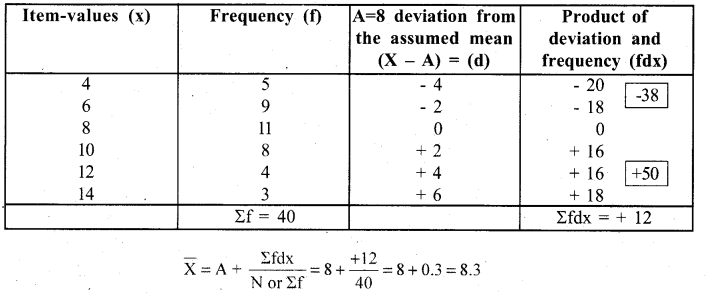
![]()
Question 4.
Explain the direct and shortcut methods for calculating the arithmetic mean in a continuous series with an example.
Answer:
The arithmetic mean is calculated in continuous series in the same way as it is calculated in discrete series. The only difference is that in continuous series, the mid-points (X) or mid-values of all classes are determined in the beginning. Upon taking the mid-values, the continuous series takes the form of discrete series.
Explain through example :
| Obtained Marks | 5-10 | 10-15 | 15-20 | 20-25 | 25-30 | 30-35 |
| No. of Students | 4 | 12 | 14 | 8 | 7 | 5 |
Solution :
| Obtained Marks C.I. | Mid-point(x) | Frequency(f) | Fx | d = x – A (A = 17.5) | fd |
| 5-10 | 7.5 | 4 | 30.0 | – 10 | – 40 |
| 10-15 | 12.5 | 12 | 150.0 | – 5 | – 60 |
| 15-20 | 17.5 | 14 | 245.0 | 0 | 0 |
| 20-25 | 22.5 | 8 | 180.0 | + 5 | + 40 |
| 25-30 | 27.5 | 7 | 192.5 | + 10 | + 70 |
| 30-35 | 32.5 | 5 | 1625 | + 15 | + 75 |
| Σf = 50 | 960 | Σfd = + 85 |
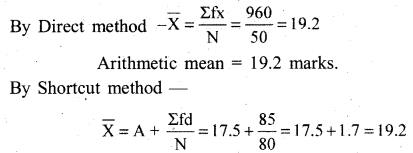
Question 5.
Explain the calculation of arithmetic mean in cumulative frequency distribution with an example.
Answer:
When the class-intervals are given on cumulative basis then first find out the frequency of various classes through the cumulative frequency. Then arithmetic mean will be calculated.
Example :
| Marks (Less Than) | 5 | 10 | 15 | 20 | 25 | 30 |
| Frequency | 4 | 16 | 30 | 38 | 45 | 50 |
Solution :
Firstly find out the classes of cumulative frequency and their frequencies.
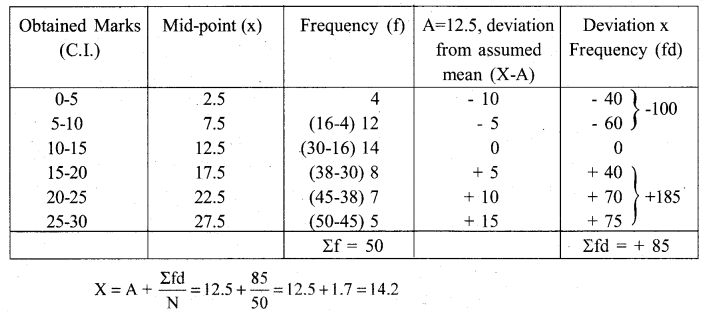
![]()
Question 6.
What is the step-deviation method of calculating arithmetic mean? When is this method used? Explain it with an example.
Answer:
Step-deviation method of arithmetic mean :
The step deviation method can only be used when the values of all items are either decreasing or increasing uniformally. The ‘step- deviation method’ is only an additional adjustment to ‘short-cut method’. Under this method, the deviations are divided by a single common factor to reduce the figures to the minimum size. The adjusted or reduced value of ‘dx’ is now termed as d’x. In such a case, the frequencies will be multiplied by the step-deviations (d’x) and not by deviations (dx). It is, in a way, a deliberate error and it is compensated by multiplying the quotient by the same number of step. This is done before adding the assumed mean.
The various steps are the following:
- Take any value (size) as assumed mean(A)
- Find out the deviations(dx) of each value from the assumed mean, dx = X – A
- Deviations (dx) are divided by a common factor (i) and such obtained value is denoted by d’ x.
- Step-deviations (d’x) are then multiplied with their frequencies to obtain fd’x.
- Add up the products of above step and such obtained value is denoted by Σfd’x.
- At the end, we apply the following formula :
\(\overline { X } \) = A +\( \frac {\Sigma fd’x}{N}\times i \)
Where, A = Assumed mean;
Σfd’x = sum of products of step deviation and their frequencies
i = Common Factor or difference between two classes
Example :
Calculate arithmetic mean by step-deviation method from the following series :
| Wages (In ₹) | 0-10 | 10-20 | 20-30 | 30-40 | 40-50 |
| No. of Worker | 8 | 12 | 20 | 6 | 4 |
Solution :
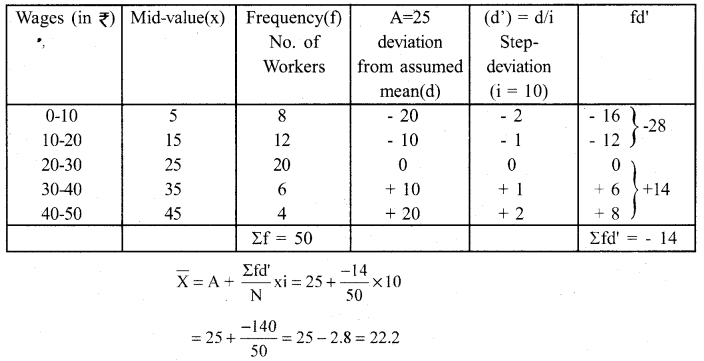
Question 7.
What is meant by weighted average mean ? When is this method used ? Explain it with an example.
Answer:
In computing simple arithmetic mean it is assumed that the importance of each item in the series is equal. But there may be cases where the relative importance of the different items is not the same. When items vary in importance they must be assigned some weights in proportion to their importance and we compute weighted arithmetic mean instead of simple arithmetic mean. Arithmetic mean calculated on the basis of weights is called weighted Arithmetic Mean.
A. Direct Method of Calculating Weighted Arithmetic Mean :
- Multiply the weights by the variables X and obtain the products XW.
- Obtain the sum of XW, which is known as ΣXW.
- Divide, the above total by the sum of the weights, i.e. ΣW. The quotient is the weighted arithmetic mean or average.
\(\overline { X }w = \frac{\Sigma xw}{\Sigma w}\)
B. Calculate weighted arithmetic mean by the shortcut method :
Following steps are taken to calculate X „ by short-cut method
- Take any value (size) as assumed mean (A).
- Find out the deviations of each value(size) from the assumed mean and denote these deviations by dx.
dx = (X – A) - Multiply these deviations with the respective Weight and denoted as ‘Wdx’.
- Add up the products and denoted as ΣWdx.
- At the end, we apply the following formula :
\(\overline { X }_{w} = A + \frac{\Sigma wdx}{N or \Sigma w}\)
Normally, the weighted average mean is calculated by direct method.
![]()
Example :
Find out the weighted average mean by direct and short-cut method with the help of given series :
| Category of Employees | Monthly Salary (In ₹) | No. of Employees |
| Principal | 42,000 | 1 |
| Senior Lecturer | 38,000 | 5 |
| Junior Lecturer | 24,000 | 8 |
| Teacher | 17,000 | 12 |
| Clerk | 12,000 | 5 |
| Peon | 7,000 | 8 |
Solution :
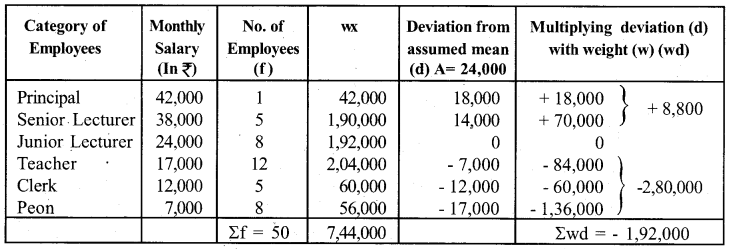

RBSE Class 11 Economics Chapter 8 Numerical Questions
Question 1.
Calculate the arithmetic mean from the data obtained in statistics from the 10 students of an exam :
| Enrolment no. | 1 | 2 | 3 | 4 | 5 | 6 | 7 | 8 | 9 | 10 |
| Obtained Marks | 16 | 24 | 18 | 48 | 36 | 28 | 32 | 41 | 23 | 12 |
Answer:
| Enrolment | Obtained Marks (X) |
| 1 | 16 |
| 2 | 24 |
| 3 | 18 |
| 4 | 48 |
| 5 | 36 |
| 6 | 28 |
| 7 | 32 |
| 8 | 41 |
| 9 | 23 |
| 10 | 12 |
| ΣX = 278 |
![]()
Question 2.
Calculate arithmetic mean from the following data :
| Item Value | 5 | 15 | 25 | 35 | 45 |
| Frequency | 4 | 7 | 12 | 4 | 3 |
Answer:


Question 3.
Calculate arithmetic mean from the following series :
| Wages (In ₹) | 0-10 | 10-20 | 20-30 | 30-40 | 40-50 |
| No. of Workers | 8 | 12 | 20 | 6 | 4 |
Answer:
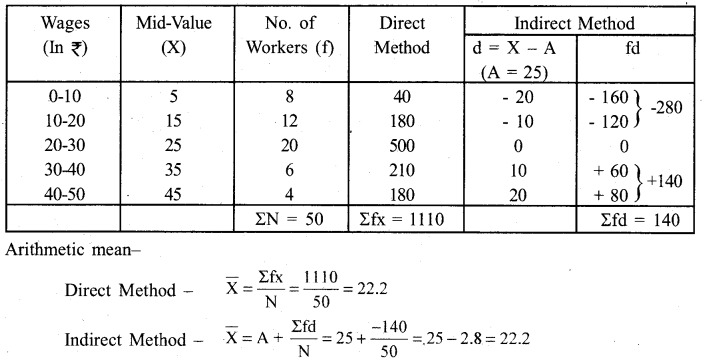
Question 4.
Calculate arithmetic mean from the following series :
| Item Value | 1-5 | 6-10 | 11-15 | 16-20 | 21-25 |
| Frequency | 2 | 5 | 8 | 6 | 4 |
Answer:
| Item-value | Mid-value (X) | Frequency (f) | fx |
| 1-5 | 3 | 2 | 6 |
| 6-10 | 8 | 5 | 40 |
| 11-15 | 13 | 8 | 104 |
| 16-20 | 18 | 6 | 108 |
| 21-25 | 23 | 4 | 92 |
| ΣN = 25 | Σfx = 350 |
Note :
Inclusive series is given in the question. There is no need to change it in an exclusive series because mid-value is similar in both series.
![]()
Question 5.
Find out arithmetic mean from the following series :
| Obtained Marks (less than) | 10 | 20 | 30 | 40 | 50 | 60 | 70 | 80 |
| No. of Students | 25 | 40 | 60 | 75 | 95 | 125 | 190 | 240 |
Answer:
| Obtained Marks | No. of Students, f | Mid-Value X | fx |
| 0-10 | 25 | 5 | 125 |
| 10-20 | 40 – 25 = 15 | 15 | 225 |
| 20-30 | 60 – 40 = 20 | 25 | 500 |
| 3040 | 75 – 50 = 15 | 35 | 525 |
| 40-50 | 95 – 75 = 20 | 45 | 900 |
| 50-60 | 125 – 95 = 30 | 55 | 1650 |
| 60-70 | 190 – 125 = 65 | 65 | 4225 |
| 70-80 | 240 – 190 = 50 | 75 | 3750 |
| Σf = 240 | Σfx = 11900 |
Question 6.
Find out arithmetic mean by step-deviation method from the following information :
| Obtained Marks (More Than) | 0 | 10 | 20 | 30 | 40 | 50 | 60 |
| No. of Students | 50 | 42 | 36 | 25 | 16 | 10 | 6 |
Answer:
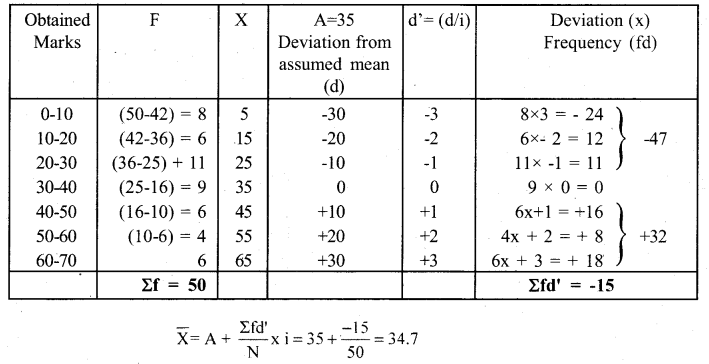
Question 7.
Find the arithmetic mean of the following data showing marks obtained by the student in a statistics exam :
| Mid Marks (X) | 5 | 10 | 15 | 20 | 25 | 30 | 35 | 40 |
| No. of Students | 5 | 7 | 9 | 10 | 8 | 6 | 3 | 2 |
Answer:
| Mid Marks (X) | No. of Students (f) | Fx |
| 5 | 5 | 25 |
| 10 | 7 | 70 |
| 15 | 9 | 135 |
| 20 | 10 | 200 |
| 25 | 8 | 200 |
| 30 | 6 | 180 |
| 35 | 3 | 105 |
| 40 | 2 | 80 |
| Σf = 50 | ΣfX = 995 |
![]()
Question 8.
Calculate weighted mean from the following given data :
| Item- Value (X) | 15 | 18 | 21 | 25 | 32 | 40 |
| Weight | 6 | 5 | 4 | 3 | 2 | 1 |
Answer:
| Item- Value (X) | Weight (W) | XW |
| 15 | 6 | 90 |
| 18 | 5 | 90 |
| 21 | 4 | 84 |
| 25 | 3 | 75 |
| 32 | 2 | 64 |
| 40 | 1 | 40 |
| ΣW = 21 | ΣXW = 443 |